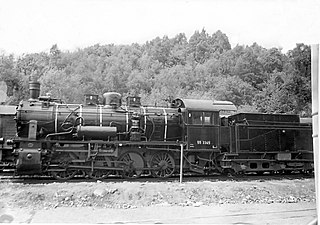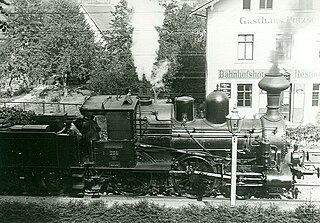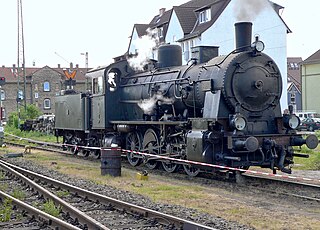
The Prussian G 8.1 was a heavier, stronger development of the G 8 and was initially referred to as a 'strengthened standard class'.

The Prussian T 18 was the last class of tank locomotives developed for the Prussian state railways. They were originally intended for services on the island of Rügen as replacements for Class T 12 and T 10 engines. They emerged when a class of locomotive was conceived in 1912 that was to handle express and passenger trains in border areas or in shuttle services on short routes. A tank engine design with symmetrical running gear was envisaged because, unlike a tender locomotive, it could run equally fast forwards and backwards and could be operated on return journeys without having to be turned on a turntable. Its power and top speed were to be the same as those of the P 8. Robert Garbe designed this 4-6-4 (2′C2′) tank locomotive for 100 km/h with a 17-ton axle load and contracted the Vulkan Werke in Stettin to build it. It was given the designation T 18.

Between 1934 and 1941 the Deutsche Reichsbahn (DRG) converted a total of 691 former Prussian-built Class 55.25–56 steam locomotives; the result was the DRG Class 56.2–8. The carrying axle enabled higher speeds and the engine could even be used as a passenger train locomotive. In addition the average axle load was lower, so that these locomotives could also be used on branch lines. The conversion entailed moving the boiler forward and raising it somewhat. The vehicles were given operating numbers between 56 201 and 56 891, although the numbering was not continuous.
The Alsace-Lorraine Class G 8.1 was a superheated, goods train, steam locomotive with four driving axles, and was based on the Prussian G 8.1. There were no design differences between the two. The Imperial Railways in Alsace-Lorraine received a total of 137 G 8.1 engines between 1913 and 1919, of which eleven were built by Henschel and the rest by the Grafenstaden. They were numbered 5151 to 5278.

The Prussian G 10 was a German goods train, steam locomotive, whose design was based on a combination of the running and valve gear from the Prussian T 16 and the boiler from the Prussian P 8. In developing the G 10, however, the T 16 running gear with side play on the first and fifth axles was modified. The T 16 was also subsequently built with this modified configuration and called the Prussian T 16.1. The G 10 was intended for heavy goods train duties on main lines, but as a result of its low axle load it could be employed more flexibly than its equally powerful cousin, the Prussian G 8.1. The G 10 was occasionally even used in passenger train service.
The Prussian T 13 was a series of tank locomotives built in large numbers for the various German state railways, notably the Prussian state railways, and the Deutsche Reichsbahn during the early part of the 20th century.

The Prussian T 16.1 locomotives were built for the Prussian state railways as goods train tank locomotives about the time of the First World War. Six examples were also procured by the Imperial Railways in Alsace-Lorraine.

The Saxon Class III b were German steam locomotives built for the Royal Saxon State Railways in the late 19th century as tender locomotives for express train duties. In 1925, the Deutsche Reichsbahn incorporated the engines into DRG Class 34.77-78.
The Prussian G 5.4 was a German goods train locomotive with a compound engine. Due to its top speed of 65 km/h it was also used on passenger services. The G 5.4, like the G 5.3, differed from the G 5.1 and G 5.2 in having a shorter wheelbase and higher boiler pitch. In addition, the Krauss-Helmholtz bogies enabled its riding qualities to be improved, especially at higher speeds. Between 1901 and 1910 a total of about 760 vehicles of the Class G 5.4 were built for the Prussian state railways. The last 25 locomotives were fitted once again with an Adams axle.

In 1905 the Prussian state railways grouped six-coupled, medium-powered, goods train, tank locomotives into its Class G 3. In addition to standard locomotives, there were also 285 G 3s that were not built to German state railway norms, because they had been built, in most cases, before the foundation of the Prussian state railways.
The Prussian Class G 4 were German, six-coupled, goods train, steam locomotives with a boiler pressure of 12 bar, built primarily for the Prussian state railways. Classified by the state railway in 1905, they included 16 locomotives from the railway division of Mainz, that originally came from the Hessian Ludwigsbahn. These earlier locomotives were delivered between 1872 and 1896 and did not meet the Prussian norms.

The Prussian Class P 6s were passenger locomotives operated by the Prussian state railways with a leading axle and three coupled axles.

The Baden VI b was the first German tank locomotive with a 2-6-2 wheel arrangement. It was developed by the firm of Maffei for the Grand Duchy of Baden State Railways in order to provide faster services on the Höllentalbahn. As a result, the first six batches were given a firebox sloping to the rear. One striking feature was also the connecting pipe between the two steam domes.
The Prussian T 9 was a class of German steam locomotive which included several types of tank engine, all with six coupled wheels and two carrying wheels operated by the Prussian state railways.

The Prussian T 14s were German, 2-8-2T, goods train, tank locomotives operated by the Prussian state railways and the Imperial Railways in Alsace-Lorraine. They were later incorporated by the Deutsche Reichsbahn into their renumbering plan as Class 93.0–4.

The Prussian Class G 8 locomotives were eight-coupled, superheated, freight locomotives operated by the Prussian state railways. There were two variants: the G 8 built from 1902 with a 14 tonne axle load and the "reinforced G 8" built from 1913 with a 17-tonne axle load. The latter was the most numerous German state railway (Länderbahn) locomotive, over 5,000 examples being built.
The Prussian G 8.2 class of locomotives actually incorporated two different locomotive types: one was the Prussian/Oldenburg G 8.2, for which the Deutsche Reichsbahn subsequently issued follow-on orders; the other was the G 8.2 of the Lübeck-Büchen Railway.

The Prussian Class T 12 is an early, German, passenger train, tank locomotive built for the Prussian state railways in large numbers. These locomotives were superheated variants of the T 11.

The Prussian T 8 were six-coupled superheated goods tank locomotives of the Prussian state railways. They were originally intended for suburban passenger service in Berlin, and for use on branch lines. Due to their poor running qualities, they were demoted to shunting and short-distance goods train service.

The Prussian G 7.3 was a class of 2-8-0 locomotives of the Prussian state railways. The third class of the G 7 series, they were intended to power heavy goods trains on steep inclines, on which the permissible axle load was not yet that high. This affected for example, the Paderborn–Holzminden and Betzdorf–Siegen routes.














